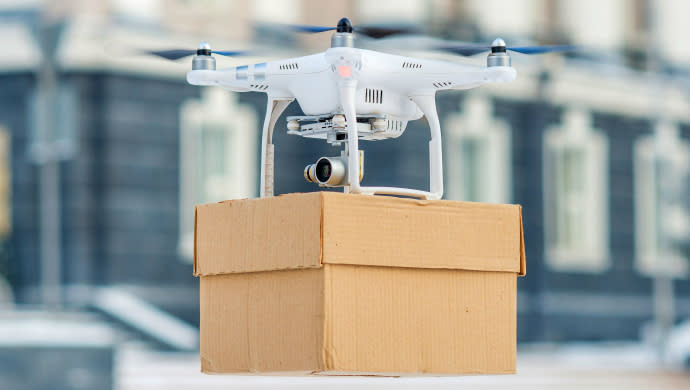JD is using drones to help rural e-commerce take off

Almost half of Chinese people live in rural areas, creating a logistics hurdle for the big e-commerce companies
A drone glides through the air over fields of green carrying a red box—the iconic red of China’s e-commerce giant JD.com—under the center of its body. When it reaches a tiny village in the eastern Chinese province of Jiangsu, the drone releases the payload to a landing pad in front of a distribution center, where a contractor picks it up and makes the final delivery to the buyer’s doorstep.
“What used to take two hours to ship… now takes about ten minutes by drone,” Eric Zhao, VP of Technology at JD, says as he plays a video to an international crowd at the RISE Conference in Hong Kong.
Revolutionizing the life of small-town Chinese
Almost half of China’s 1.3 billion people still live in rural areas. Poor infrastructure, fewer orders, and higher logistics fees have long been a challenge for China’s e-commerce companies. JD’s rural drone plan, however, came at a time when the nation’s urban-rural income gap is narrowing and internet penetration is growing.
A report released by the OECD (Organisation for Economic Co-operation and Development) on July 1 shows that the share of China’s rural population living below the poverty line fell from 30% in 2005 to 5.7% in 2015. The rise in rural income has boosted rural e-commerce where small-town residents can enjoy aspects of urban quality and convenience without having to relocate to expensive and competitive cities.
“In some of the rural, underdeveloped provinces, the percentage of orders from smartphones is more than 90 per cent. That actually bridges the gap between the countryside and the big cities,” says Zhao. “Now there are a lot of rural customers who are able to access products which before were never available to them. They are pursuing quality.”
The purchasing power of China’s rural consumers, according to Zhao, is in fact “neck and neck” with their urban counterparts.
And they are not satisfied with just products from the more prosperous big cities. A 2016 white paper released by JD (in Chinese) shows that cross-border e-commerce is booming in the countryside, driven by direct purchases of foreign cosmetics, baby products, watches, small electronic appliances and health products through JD Worldwide (全球购), the company’s cross-border e-commerce platform launched in 2015.
“They are the Internet generation, and they also want their children to have the best food, just as good as the big city families’.” According to Zhao, the rural Chinese buying off JD Worldwide are post-90s living in fifth- or sixth-tier cities. “The real countryside,” he says.
JD is hardly doing the rural expansion alone; it is getting a big helping hand from the government who aims to boost consumer spending and invigorate China’s “backward” regions. According to the OECD report, China aims to lift the remaining 43.3 million rural poor out of poverty by 2020.
It comes as no surprise that JD’s logistics hub launched in May is a collaboration with Xi’an’s National Civil Aerospace Industrial Base, part of its strategic partnership deal with the provincial government of Shaanxi, of which Xi’an is the capital city.
The rural tug of war
Alibaba, China’s largest e-commerce retail platform by revenue followed by JD, is also targeting far-flung villages for e-commerce growth. One initiative is “Rural Taobao”, with an estimated investment of $1.6 billion since 2014. The program is an ambitious effort to turn China’s rural residents, many of whom have no knowledge of or access to the Internet, into online shoppers and sellers.
Unlike Alibaba, which relies heavily on third-party delivery services, JD operates much of the logistics chain needed to convey its orders, a costly undertaking especially for rural e-commerce, that has prompted the company to improve logistics efficiency. Drones, says founder and CEO Richard Liu, are the best way to reach the fast growing rural consumers. “That kind of logistics fee will drop down at least 70 percent, so on our balance sheet, I think it will be profitable,” he said in an interview with CNBC.
As Seeking Alpha puts it, the JD-Alibaba relationship is reminiscent of the differences between Amazon and eBay, where “one company has looked to invest and grow through fulfillment facilities and transportation through the incorporation of technology, while the other has focused on technology infrastructure to develop a robust marketplace platform.”
JD already has drones that fly up to 100km per hour with packages weighing from 5kg to 30kg. By the end of 2017, the company is looking to ply 100 regular drone delivery routes to bring goods to China’s remote areas. The e-commerce titan has also built a drone R&D center in Xi’an focusing on operating middle- and large-sized drones that can carry 200 kilograms to two tons in order to cut storage costs.
JD’s rival Alibaba is more skeptical about the promise of drone delivery. “What if the drones are knocked down? Or fall by themselves?” Alibaba’s Founder Jack Ma said last year at Global Smart Logistics Summit: “Making [drone delivery] actually happen still takes time.” Instead, he is putting more hope into robots. According to local media, Alibaba’s logistics arm Cainiao has already finished testing its self-developed delivery robots and warehouse robots (in Chinese). “We should not let humans do the simple, repetitive work,” stated Ma.
—
Copyright: agnormark / 123RF Stock Photo
The article JD is using drones to help rural e-commerce take off first appeared on Technode.
The post JD is using drones to help rural e-commerce take off appeared first on e27.



